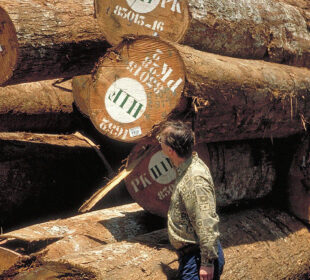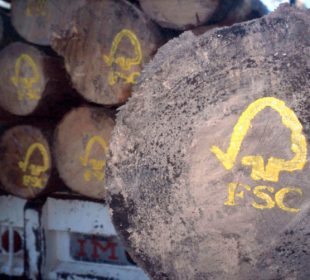The European Union aims to adopt a new regulation by the end of the year to restore natural ecosystems but several issues, including forestry, still create controversy among EU legislators.
“My aim above all is to find consensus,” said César Luena, a Spanish socialist lawmaker who is the European Parliament’s rapporteur on the EU’s new nature restoration law tabled in June last year.
“We need to focus on the restoration of nature,” he said at a meeting of the Parliament’s environment committee on Thursday (12 January). “This needs to come from this committee and be moved to the plenary with consensus,” he added.
In June last year, the European Commission tabled a new Nature Restoration Law, which for the first time introduces legally-binding targets to restore degraded land and reverse biodiversity loss.
The plan also includes a €100 billion budget for EU member states to restore nature in agriculture, forests, oceans and urban areas.
However, EU countries appear reluctant. During a meeting in December last year, the bloc’s 27 environment ministers voiced concern about several aspects of the proposed regulation, including the lack of flexibility for member states to meet the targets and insufficient financing.
Debate on targets
In the European Parliament too, right-wing and conservative political groups have been critical of the proposal, which for the first time sets legally-binding targets on member states to restore 20% of the EU’s land and sea area by 2030.
The proposed targets – seven in total – seek to address the issue from several fronts, such as reversing the decline of pollinator populations by 2030, removing river barriers, or stopping the net loss of green urban spaces by 2030.
These are expected to be the main sticking point during negotiations to approve the new law.
“Everybody knows the Commission’s proposal as it stands will not be supported by the EPP in plenary,” said Peter Liese, a German Christian Democrat lawmaker affiliated with the Parliament’s centre-right European People’s Party (EPP).
According to Liese, more dialogue and coordination is needed with landowners and farmers who will be directly affected by the new law.
There will be “a lot of amendments from the EPP” on the draft report, he warned fellow environment committee members on Thursday.
Others in Parliament want to strengthen the ambition of the proposal. This is the intention for instance of César Luena, the Spanish MEP who is the Parliament’s rapporteur on the draft bill.
While the draft Nature Restoration Law sets an overarching target of restoring 20% of the EU’s land and seas by 2030, Luena wants to raise this target to 30%, in line with the decision adopted in December at the COP15 UN Biodiversity Conference in Montreal.
Forestry under the spotlight
If approved in its current form, the new law would commit the European Union to legally protect all remaining primary and old-growth forests on its territory. The objective is to achieve an overall increase in biodiversity and a positive trend for forest connectivity, deadwood, share of uneven-aged forests, forest birds and stock of organic carbon.
But some MEPs argue the Commission’s proposal ignores the regional diversity of forests and their socioeconomic role.
“For thousands of years, people have been managing these forests,” said Ulrike Müller, a German MEP from the centrist Renew Europe group. “We have to shape our forests for the future in an active way, and naturally, we’re going to need the help and the involvement of the people who own the forests,” he said.
The issue of forest management is particularly sensitive for Nordic and Baltic countries, which have large forestry sectors and are home to strong wood, pulp and paper industries.
In five EU Member States, more than half of the land area in 2020 was covered with forests, according to Eurostat data: Finland (66%), Sweden (63%), Slovenia (61%), Estonia (54%) and Latvia (53%).
Nordic countries have previously pushed back against forestry-related targets for this reason, parliamentary sources told EURACTIV, adding that this will become an issue also when it comes to the nature restoration law.
Sweden kept silent on the matter when the EU’s nature restoration law was debated last December at the EU’s Environment Council, saying it needed to remain neutral because of the country’s incoming EU Presidency, which started on 1 January for a duration of six months.
Campaigners, by contrast, are more vocal, with activists expressing worries that Sweden’s forestry sector will weigh on the Presidency to dilute forestry provisions in the EU’s nature restoration law.
“Sweden’s relationship with their forests is strained despite the promotion of their forestry model, and this doesn’t bode well for an ambitious law,” said Kelsey Perlman from FERN, a forest NGO. According to her, nature restoration targets make sense not just for the environment but also for the economic sustainability of the forestry sector.
As the current holder of the EU’s six-month rotating presidency, Sweden is supposed to remain neutral during EU negotiations. But campaigners say it will be represented by others such as the Nordic and the Baltic states when it comes to forestry aspects.The nature restoration regulation is expected to be voted in the European Parliament at its June plenary session. The Swedish presidency, meanwhile, aims to reach a “general approach” among EU member states at the Environment Council taking place the same month. Talks between Parliament and EU countries will then take place from July onwards, under the Spanish EU presidency, with the expectation to reach a final agreement by the end of 2023.
















